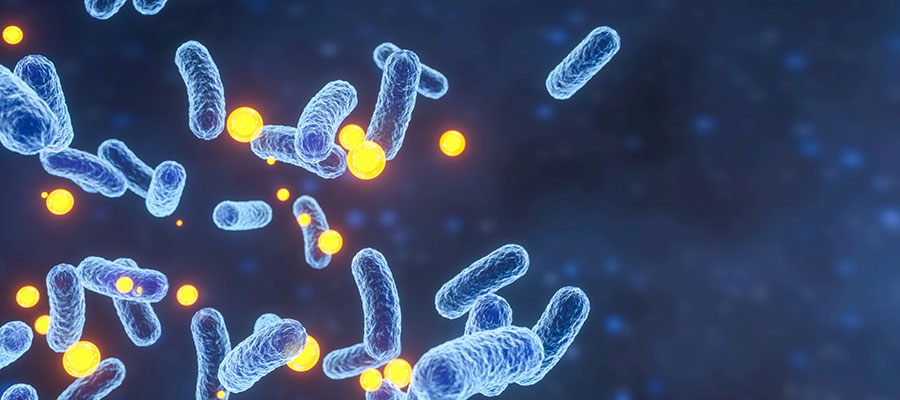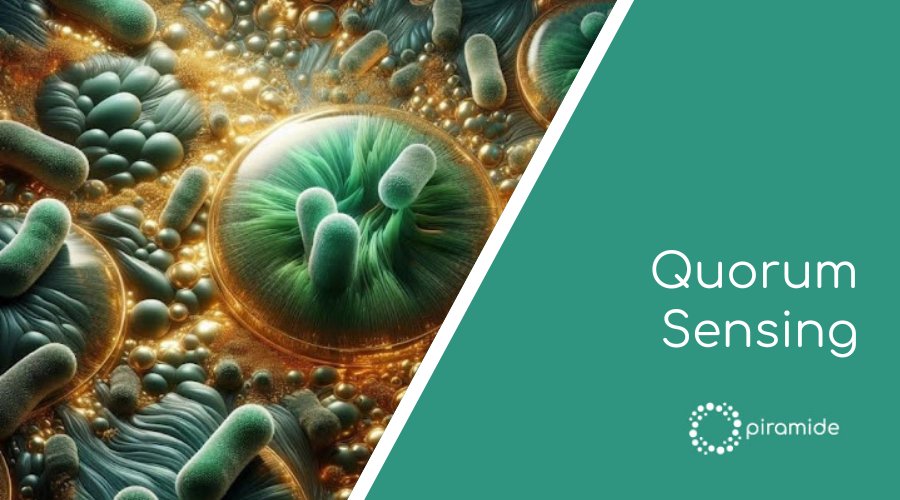Bacterial cells communicate with each other and communication plays an essential role in virulence and biofilm formation.
Communication takes place via cells that release, detect and then respond to small, diffusible signal molecules. This process is called quorum sensing.
Quorum sensing controls the behaviour of bacterial groups in complex, dynamically changing environments.
Bacteria use quorum sensing to:
- facilitate colonisation;
- form biofilms;
- control virulence factors;
- promote cooperative behaviour;
- as a defence against other competing microorganisms;
- promoting adaptation to environmental changes.
To consider bacteria simply as independent single-celled organisms is erroneous.
Most bacteria in the natural environment are not found in the state of free, ‘pure’ cells. Instead, they exist in complex and dynamic surface-associated communities called biofilms. It is within heterogeneous biofilm communities that bacteria communicate and adapt, using quorum sensing.
For this process, bacteria do not need to be physically in contact, but simply close enough to detect secreted molecules.
The interesting aspect of quorum sensing is how bacterial communities such as biofilms can regulate various physiological processes and group activities through group signalling. In a way, biofilm communities are like vast cities of bacteria where quorum sensing controls traffic flows, hospital admissions and when to go to war.

Quorum sensing helps an initial population to establish and develop a biofilm community; chemicals released by the first colonisers trigger changes in gene expression, inducing other bacteria to change their lifestyle from planktonic to sessile.
Studies show that the presence of quorum sensing is associated with more robust biofilm communities.
For example, bacterial adhesion appears to be significantly stronger as the levels of secreted molecules increase; at the same time, biomass increases correspondingly. Among the quorum-sensitive molecules called N-acyl-homoserine lactones (used by many Gram-negative bacteria), long-chain variants (12-14 carbon atoms) are more strongly associated with bacterial adhesion.
This is probably due to the higher hydrophobicity and resistance to hydrolysis of these molecules.
Through quorum sensing, different bacteria can choose to compete or cooperate.
With cooperation, different species can act together to strengthen the community. Here, some bacteria benefit from the division of labour, collective actions and other forms of cooperative activities, including the allocation of nutrients (e.g. through social cooperation, in response to a nutrient shortage, one part of the population is allocated nutrients and survives while other cells go hungry. Such forms of cooperation are more likely to have evolved between genetically related individuals.
Not all species are cooperative and some will benefit from cooperating species to promote their own growth and survival. These are sometimes referred to as ‘cheaters “ or ”non-cooperators’.
The quorum plays an important role in the development of biofilms. This is to the extent that there is often a clear connection between quorum sensing and biofilm formation. Bacteria in microbial biofilms have different characteristics from their free-living counterparts, including significantly increased resistance to antimicrobials, decontamination methods and antibiotics. Quorum sensing increases resistance by altering biofilm development, bacterial secretory systems and bacterial efflux pumps.
In fact, quorum sensing can signal some cells to go into dormancy as a survival tactic, making them less susceptible to disinfectants, antimicrobial agents, antibiotics and unfavourable environmental conditions (low water activity, pH and unsuitable temperatures).
Quorum sensing is linked to several virulence factors in relation to specific bacteria, including regulation of the timing at which they release specific toxins.
Quorum-sensitive bacteria produce and release chemical signal molecules such as self-inducers. These molecules increase in concentration as a function of cell density.

Quorum sensing occurs through four stages:
- intracellular synthesis of signal molecules;
- secretion of the molecules, active or passive;
- detection of the signal molecule and its binding to an inducer;
- activation of gene transcription.
For Gram-positive bacteria capable of forming endospores, quorum sensing can be used to signal to a community when conditions are suitable for sporulation.
The phenomenon of quorum sensing is therefore crucial for regulating the microbial community within the biofilm matrix. This is why acting on the matrix, rather than on individual microbial cells, is the best way to destabilise the microbial community, reduce its interactions and thus lead to a complete and effective elimination of the biofilm.
The patented BIOREM® treatment, specifically for biofilm removal, acts in a single wash to hydrolyse the protective matrix, and eliminate biofilm-bound microorganisms if present.
The washing solutions can also be analysed using both classical microbiological techniques and innovative techniques such as metagenetics, the flagship of the services offered by Piramide and Realco.
A BIOREM® treatment can protect against high risks.



